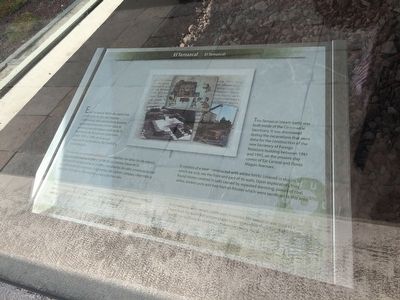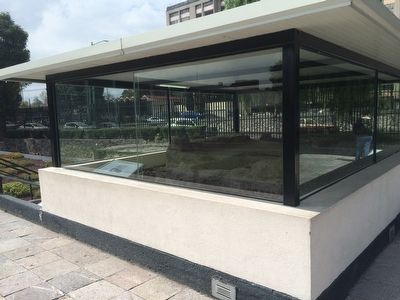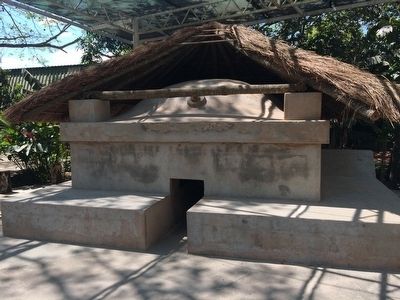Colonia Tlatelolco in Ciudad de México, Mexico — The Valley of Mexico (The Central Highlands)
El Temazcal
Inscription.
Este Temazcal (Baño de vapor) fue construido dentro del Recinto Ceremonial, descubriéndose durante las excavaciones efectuadas para la construcción del nuevo edificio de la Secretaria de Relaciones Exteriores entre 1991 y 1993, en la actual esquina de las Avenidas Eje Central y Flores Magón.
Se trata de un aposento elaborado con adobes recubiertos de estuco, del cual sólo vemos el piso y parte de los muros. Durante la exploración se encontraron piedras recubiertas de sales provocados por el calentamiento reiterado, fragmentos de carbón, cenizas, ollas rotas y dos fetos humanos ofrendados a esta construcción.
De acuerdo con algunos códices y crónicas, el temazcal fue utilizado como baño de vapor con fines medicinales y para facilitar el trabajo de parto, además de ser parte de algunos rituales de purificación.
Pie de dibujos:
El temazcal en el códice Magliabecciano
Traslado de Temazcal a su ubicación actual
El temazcal en su ubicación original
This Temazcal (steam bath) was built inside of the Ceremonial Sanctuary. It was discovered during the excavations that were done for the construction of the new Secretary of Foreign Relations building between 1991 and 1993, on the present-day corner of Eje Central and Flores Magón Avenues.
It consists of a room constructed with adobe bricks covered in stucco, of which we only see the floor and part of its walls. Upon exploration, they found stones covered in salts caused by repeated warming, pieces of coal, ashes, broken pots and two human fetuses which were sacrificed in this area.
In accordance with certain codex and chronicles, the temazcal was used as a steam bath for medicinal purposes and to accommodate the labor of childbirth. In addition to being and element in certain cleansing rituals.
English translation of captions:
The temazcal in the Magliabecciano Codex
Moving the Temazcal to its current location
The temazcal in its original location
Topics. This historical marker is listed in these topic lists: Anthropology & Archaeology • Man-Made Features. A significant historical year for this entry is 1991.
Location. 19° 27.072′ N, 99° 8.279′ W. Marker is in Ciudad de México. It is in Colonia Tlatelolco. The marker is at the Tlatelolco Archeological Site on Eje Central near the intersection with Avenida Ricardo Flores Magón. Touch for map. Marker is in this post office area: Ciudad de México 06900, Mexico. Touch for directions.
Other nearby markers. At least 8 other markers are within walking distance of this marker. Between the past and the modern times (a few steps from this marker); Templo Mayor: a temple built eight times (within shouting distance of this marker); Tlatelolco: a well-planned city (within shouting distance of this marker); The Tlatelolco Lovers (within shouting distance of this marker); The Southern Plaza of the Sanctuary (within shouting distance of this marker); The Great Base: findings upon findings (within shouting distance of this marker); Stage 1 of the Templo Mayor de Mexico Tlatelolco (within shouting distance of this marker); Superimposed altars (within shouting distance of this marker). Touch for a list and map of all markers in Ciudad de México.
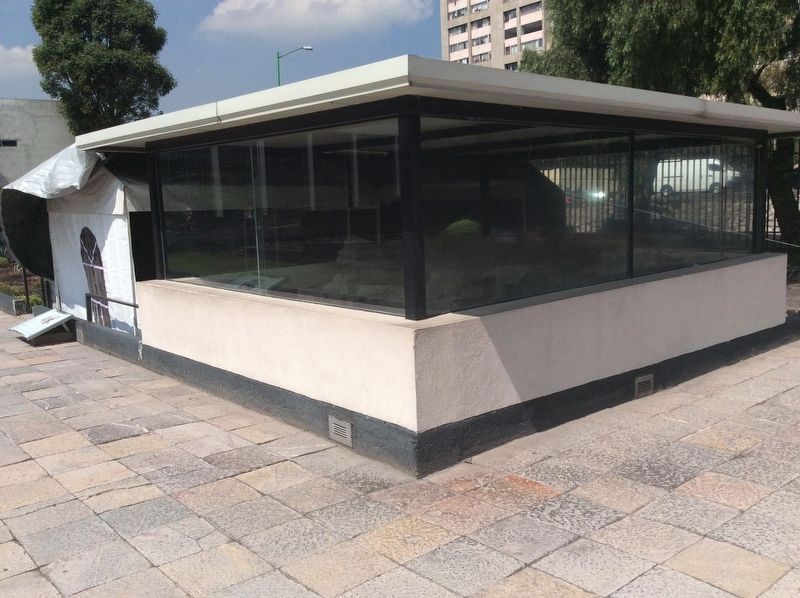
Photographed By J. Makali Bruton, August 7, 2017
3. Renewed excavations near the El Temazcal Marker
The additional marker to the south of the temazcal has been moved due to renewed archaeological excavations in the area. Note the plastic covering over the excavation to the south (left) of the temazcal.
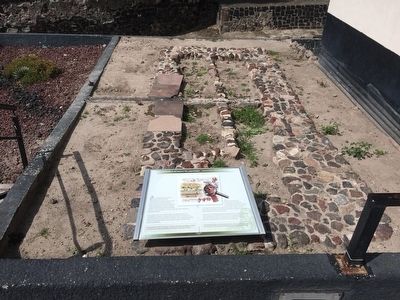
Photographed By J. Makali Bruton, November 2, 2015
5. Treasure hunters? No, archaeologists
This educational marker is directly to the left of the El Temzacal marker. It reads: ¿Buscadores de tesoros? No, arqueólogos
¿Te has preguntado por qué los arqueólogos hacen pozos? El arqueólogo excava porque año con año, en el suelo se va acumulando tierra, hojas de plantas, nuestra propia basura y cosas que perdemos. Y eso ha sucedido durante toda la historia de la humanidad, por eso se van formando en el suelo capas de colores distintos y texturas diferentes.
Bajo nuestros pies, se esconden edificios y objetos hechos en la antigüedad y también los huesos de quienes los hicieron. Por eso el arqueólogo hace pozos de manera cuidadosa. Sólo así puede encontrar datos que le permite saber cómo eran, qué comían y qué hacían los antiguos pobladores.
El arqueólogo no buscar oro, joyas, ni tesoros. Su interés y verdadero “tesoro” es la información sobre los pueblos que existieron antes que nosotros.
English: Have you wondered why archaeologists make pits? The archaeologist excavates because year after year plant leaves, our own trash and things that we lose are accumulated in the earth. This has occurred throughout human history, and because of that layers of distinct colors and different textures are formed in the earth.
Under our feet are hidden buildings and objects made anciently, and also the bones of those who made them. That is why the archaeologist makes pits carefully. Only in this way can he find information that allows him to know how they were, what they ate, and what the ancient peoples did.
The archaeologist does not look for gold, jewels, or treasure. His interest and true “treasure” is the information about the peoples that existed before us.
Bajo nuestros pies, se esconden edificios y objetos hechos en la antigüedad y también los huesos de quienes los hicieron. Por eso el arqueólogo hace pozos de manera cuidadosa. Sólo así puede encontrar datos que le permite saber cómo eran, qué comían y qué hacían los antiguos pobladores.
El arqueólogo no buscar oro, joyas, ni tesoros. Su interés y verdadero “tesoro” es la información sobre los pueblos que existieron antes que nosotros.
English: Have you wondered why archaeologists make pits? The archaeologist excavates because year after year plant leaves, our own trash and things that we lose are accumulated in the earth. This has occurred throughout human history, and because of that layers of distinct colors and different textures are formed in the earth.
Under our feet are hidden buildings and objects made anciently, and also the bones of those who made them. That is why the archaeologist makes pits carefully. Only in this way can he find information that allows him to know how they were, what they ate, and what the ancient peoples did.
The archaeologist does not look for gold, jewels, or treasure. His interest and true “treasure” is the information about the peoples that existed before us.
Credits. This page was last revised on April 17, 2020. It was originally submitted on January 4, 2016, by J. Makali Bruton of Accra, Ghana. This page has been viewed 374 times since then and 5 times this year. Photos: 1, 2. submitted on January 4, 2016, by J. Makali Bruton of Accra, Ghana. 3. submitted on August 12, 2017, by J. Makali Bruton of Accra, Ghana. 4, 5. submitted on January 4, 2016, by J. Makali Bruton of Accra, Ghana.
